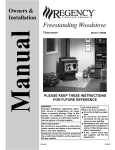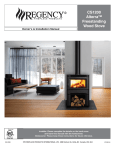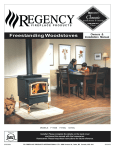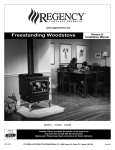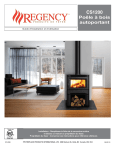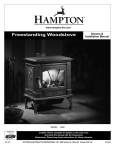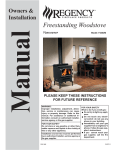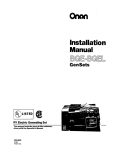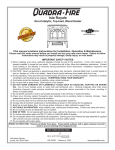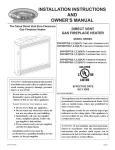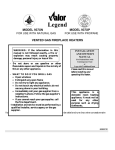Download Hampton Direct H300 User's Manual
Transcript
www.hampton-fire.com Freestanding Woodstove MODEL: Tested by: 918-214c Owners & Installation Manual H300 Installer: Please complete the details on the back cover and leave this manual with the homeowner. Homeowner: Please keep these instructions for future reference. FPI FIREPLACE PRODUCTS INTERNATIONAL LTD. 6988 Venture St., Delta, BC Canada, V4G 1H4 04/13/06 Thank-you for purchasing a HAMPTON FIREPLACE PRODUCT. The pride of workmanship that goes into each of our products will give you years of trouble-free enjoyment. Should you have any questions about your product that are not covered in this manual, please contact the HAMPTON DEALER in your area. Keep those HAMPTON FIRES burning. SAFETY NOTE: If this woodstove is not properly installed, a house fire may result. For your safety, follow the installation instructions, contact local building, fire officials, or authority having jurisdiction about restrictions and installation inspection requirements in your area. The authority having jurisdiction should be consulted before installation to determine the need to obtain a permit. 2 Hampton H300 Cast Freestanding Woodstove TABLE OF CONTENTS SAFETY LABEL OPERATING INSTRUCTIONS Safety Label for H300 ....................................................4 Operating Instructions .................................................20 Fan Operation .............................................................20 First Fire ......................................................................20 Safety Guidelines And Warnings .................................21 Draft Control ................................................................21 Ash Disposal ...............................................................22 Creosote ......................................................................23 Glass Maintenance ......................................................23 INSTALLATION Unit Dimensions ............................................................5 Pre-installation Assembly ..............................................6 Residential Installation ..................................................7 Modular Installation Options ..........................................7 Minimum Clearance To Combustible Materials .............8 Minimum Alcove Clearance To Combustible Materials ...................................................9 Additional ClearancesFor Backwall Exit ........................9 Floor Protection ...........................................................10 How To Determine If Alternate Floor Protection Materials Are Acceptable .................. 11 Step-by-Step Chimney And Connector Installation ..... 11 FactoryBuilt Chimney .................................................. 11 Masonry Chimney .......................................................12 Masonry Fireplace .......................................................12 Combustible Wall Chimney Connector Pass-Throughs ..........................................13 Recommended Heights For Woodstove Flue..............14 Mobile Home Installation .............................................15 Listed Components For Mobile Home Installation .......16 Brick Installation ..........................................................17 Door Removal .............................................................17 Glass Installation .........................................................17 Optional Blower / Fan Installation ................................18 Side Shelf Installation ..................................................19 Hampton H300 Cast Freestanding Woodstove MAINTENANCE Maintenance ................................................................23 Wood Storage..............................................................23 Handle Replacement ...................................................24 Latch Adjustment Method ............................................24 Side Door Adjustment ..................................................24 Front Door Gasket .......................................................24 Side Door Gasket ........................................................24 PARTS LIST H300 Main Assembly ...................................................25 H300 Door Assembly ...................................................27 H300 Firebrick .............................................................28 WARRANTY Warranty ......................................................................31 3 SAFETY LABEL This is a copy of the label that accompanies each Hampton H300 Freestanding Woodstove. We have printed a copy of the contents here for your review. NOTE: Hampton units are constantly being improved. Check the label on the unit and if there is a difference, the label on the unit is the correct one. SAFETY LABEL FOR H300 MODEL: HAMPTON CAST FREESTANDING WOOD STOVE - H300 TESTED TO: UL 1482 / ULC S627 REPORT NO:219-S-04-2 MEASURE FLUE FROM HEATER CENTER-LINE RESIDENTIAL INSTALLATION USING SINGLE WALL CONNECTOR SIDEWALL A 431 mm / 17 in D 762 mm / 30 in BACKWALL B 381 mm / 15 in E 381 mm / 15 in CORNER C 330 mm / 13 in F 483 mm / 19 in K 457 mm / 18 in L 150 mm / 6 in M 150 mm / 6 in MANUFACTURED BY: FPI FIREPLACE PRODUCTS INTERNATIONAL LTD. 6988 VENTURE ST. MADE IN CANADA DELTA, BC V4G 1H4 UNITED STATES ENVIRONMENTAL PROTECTION AGENCY CERTIFIED TO COMPLY WITH JULY 1990 PARTICULATE EMISSION STANDARDS. CAUTION HOT WHILE IN OPERATION DO NOT TOUCH. KEEP CHILDREN, CLOTHING AND FURNITURE AWAY. CONTACT MAY CAUSE SKIN BURNS. READ NAMEPLATE AND INSTRUCTIONS. 4 918-216 rev. 09/05 JUL JUN 2007 MINIMUM ALCOVE CEILING HEIGHT: 1.5 M / 5 FT MAXIMUM ALCOVE DEPTH 1220 MM / 48 IN. MINIMUM CLEARANCES FOR HORIZONTAL CONNECTOR TO CEILING: 457 MM / 18" THE SPACE BENEATH THE HEATER MUST NOT BE OBSTRUCTED. OPERATE ONLY WITH FIREBRICKS IN PLACE. FOR USE WITH SOLID WOOD FUEL ONLY. USE OF OTHER FUELS MAY DAMAGE HEATER AND CREATE A HAZARDOUS CONDITION. DO NOT OBSTRUCT COMBUSTION AIR OPENINGS. OPERATE ONLY WITH FIREBRICKS IN PLACE. OPERATE ONLY WITH DOOR CLOSED - OPEN FEED DOOR TO FEED FIRE ONLY. DO NOT USE GRATE OR ELEVATE FIRE. BUILD WOOD FIRE DIRECTLY ON HEARTH. DO NOT OVERFIRE - IF HEATER OR CHIMNEY CONNECTOR GLOWS YOU ARE OVERFIRING. INSPECT AND CLEAN CHIMNEY AND CONNECTOR FREQUENTLY. UNDER CERTAIN CONDITIONS OF USE CREOSOTE BUILDUP MAY OCCUR RAPIDLY. KEEP FURNISHINGS AND OTHER COMBUSTIBLE MATERIAL AWAY FROM HEATER. REPLACE GLASS ONLY WITH NEOCERAM GLASS. COMBUSTIBLE FLOOR MUST BE PROTECTED BY NON-COMBUSTIBLE MATERIAL EXTENDING BENEATH THE HEATER AND TO THE FRONT AND SIDES AS INDICATED OR TO THE NEAREST PERMITTED COMBUSTIBLE MATERIAL. OPTIONAL COMPONENT: FAN (846-515), ELECTRICAL RATING: VOLTS 115, 60 HZ, 2 AMPS DANGER: RISK OF ELECTRIC SHOCK. DISCONNECT POWER BEFORE SERVICING UNIT. DO NOT ROUTE POWER CORD UNDER OR IN FRONT OF APPLIANCE. COMPONENTS REQUIRED FOR MOBILE HOME INSTALLATION: OUTSIDE AIR KIT AND ONE OF THE FOLLOWING DOUBLE WALL CONNECTOR IN CANADA: LISTED SECURITY MODEL DP, OR OLIVER MACLEOD PRO-VENT PV DOUBLE WALLED CONNECTOR WITH LISTED CHIMNEY SYSTEM: SECURITY MODEL S2100, ICC EXCEL 2100. IN USA: LISTED DOUBLE WALL CONNECTORS SECURITY MODEL DP, SELKIRK MODEL DS, OLIVER MACLEOD PRO VENT PV, SIMPSON DURA VENT MODEL DVL, GSW SUPER PIPE 6, METAL-FAB DOUBLE WALL. CONNECTED TO ONE OF THE FOLLOWING COMPATIBLE CHIMNEY SYSTEMS SECURITY MODEL S2100 OR MODEL ASHT, SELKIRK MODEL SSII, OLIVER MACLEOD PRO JET 3103, SIMPSON DURA PLUS, GSW MODEL SC OR METAL-FAB TEMP/GUARD, AMERI-TECHS, ICC EXCEL 2100 . USE CHIMNEY COMPONENTS AS SPECIFIED IN INSTALLATION INSTRUCTIONS. 2006 I 711 mm / 28 in J 330 mm / 13 in 2005 Minimum clearance with side load door in use is 18" (457mm) to side wall or refer to dimension (A) if side load door is not used. MAY Floor protection must be a minimum of 3/8" thick with a minimum k factor of 0.84. APR G 381 mm / 15 in H 330 mm / 13 in IF SIDE LOAD DOOR IS USED: Floor protection must extend 18" (457mm) from the side of the unit to the wall. MAR SIDEWALL BACKWALL K FRONT * In Canada, ßoor protection must extend 18" (457mm) to the front and 8" (200mm) to each side and back of the stove. FEB INSTALLATION USING LISTED DOUBLE WALL CONNECTOR - ALCOVE L JAN INSTALLATION USING LISTED DOUBLE WALL CONNECTOR - RESIDENTIAL CLOSE CLEARANCE SIDEWALL A 381 mm / 15 in D 711 mm / 28 in BACKWALL B 254 mm / 10 in E 254 mm / 10 in CORNER C 228 mm / 9 in F 381 mm / 15 in O DATE OF MANUFACTURE INSTALLATION USING LISTED DOUBLE WALL CONNECTOR - MOBILE HOME A 381 mm / 15 in D 711 mm / 28 in B 254 mm / 10 in E 254 mm / 10 in C 228 mm / 9 in F 381 mm / 15 in SIDEWALL BACKWALL CORNER BACK M SIDE FLOOR PROTECTION* SIDE MINIMUM CLEARANCES TO COMBUSTIBLE MATERIALS SEPT INSTALL AND USE ONLY IN ACCORDANCE WITH THE MANUFACTURER'S INSTALLATION AND OPERATING INSTRUCTIONS. CONTACT LOCAL BUILDING OR FIRE OFFICIALS ABOUT RESTRICTIONS AND INSTALLATION INSPECTION IN YOUR AREA. USE 150 MM (6 IN.) DIAMETER MINIMUM 24 MSG BLACK OR 26 MSG BLUED STEEL CONNECTOR WITH LISTED UL103 HT FACTORY-BUILT CHIMNEY SUITABLE FOR USE WITH SOLID FUELS OR MASONRY CHIMNEY. SEE LOCAL BUILDING CODE AND MANUFACTURER'S INSTRUCTIONS FOR PRECAUTIONS REQUIRED FOR PASSING A CHIMNEY THROUGH A COMBUSTIBLE WALL OR CEILING. DO NOT PASS CHIMNEY CONNECTOR THROUGH COMBUSTIBLE WALL OR CEILING. DO NOT CONNECT THIS UNIT TO A CHIMNEY FLUE SERVING ANOTHER APPLIANCE. OCT 254 NOV DEC DO NOT REMOVE THIS LABEL AUG LISTED SPACE HEATER, SOLID FUEL TYPE, ALSO SUITABLE FOR MOBILE HOME INSTALLATION Hampton H300 Cast Freestanding Woodstove INSTALLATION UNIT DIMENSIONS Top View Front View Hampton H300 Cast Freestanding Woodstove Side View 5 INSTALLATION PRE-INSTALLATION ASSEMBLY After removing the stove from its packing, open the front door and remove the contents from the firebox, leaving the bricks in place. Rotating Elbow Side Load Door Handle This stove can be connected to either a top or rear vent exit by simply reversing the orientation of the elbow. 1) To install side door handle, remove side door plug assembly. Simply remove the 2 screws, change the position of the elbow as desired and secure in place with screws. Side Door Plug Assembly Door Latch Bar Draft Control Lever Handle 1) Insert bolt and lock washer through draft control lever hole. 2) Place handle through bolt. Tighten to secure. Hex Nuts Side Door Plug Flat Washers Rear Heat Shield 1) Loosen the bolts that secure the elbow to the unit. Ensure elbow does not fall off. Handle Washer Bolt 2) Bend the tabs on the rear heat shield inwards 90 degrees. 2) Assemble handle by: a) Placing lock washer over hex head bolt. b) Place hex head bolt into handle. c) Place spacer over hex head bolt threads. d) Screw handle into side door latch. Latch Spacer Handle Draft Control Lever Bend tabs inwards 90 degrees. 3) Slide the tabs on the rear heat shield in between the bolt and washer. Please Note: The shield needs to be stretched/ flexed in order to fit in place. Lock Washer Hex Head Bolt 3) Place side door handle latch through side door hole. 4) Re-assemble side door plug assembly to secure. Latch Side Door Plug Assembly Slide tabs in between washer and bolt. Rear Heat Shield 4) Once rear heat shield is evenly in place, tighten bolts to secure. 6 Hampton H300 Cast Freestanding Woodstove INSTALLATION RESIDENTIAL INSTALLATION 1) Please read this entire manual before you install and use your new woodstove. Failure to follow instructions may result in property damage, bodily injury or even death. Be aware that local Codes and Regulations may override some items in this manual. Check with your local inspector. 2) Select a position for your Hampton Stove. Consult the minimum clearance chart for your model and set the stove in place. For close clearance installation use listed double wall connector systems. 3) To insure vertical alignment, suspend a plumb bob from the ceiling over the exact center of your stove flue and mark a spot on the ceiling to indicate the center of the chimney. 4) Check that the area above the ceiling is clear for cutting. Re-confirm the clearance from the stove to combustibles to insure that they are within the prescribed limits. 5) This woodstove must be connected to a UL 103 HT (ULC S629) listed chimney or a code approved masonry chimney with a flue liner. 6) Install chimney according to chimney manufacturers instructions. The performance of your woodstove is governed to a very large part by the chimney system. Too short a chimney can cause difficult start-up, dirty glass, backsmoking when door is open, and even reduced heat output. Too tall a chimney may prompt excessive draft which can result in very short burn times and excessive heat output. The use of an inexpensive flue pipe damper may be helpful in reducing excessive draft. CAUTION: The chimney should be the same size as the 6" (152mm) flue outlet on the stove. The chimney must be listed as suitable for use with solid fuels. For other types of chimneys check with your local building code officials. Do not confuse a chimney with a type “B” Venting System used for gas appliances as suitable for a wood burning appliance (refer to the Mobile Home installations section). 7) Mark the location of the legs on the floor, then move the stove aside and mark the position of the floor protector. 8) The floor protector must be of non-combustible material and must extend 18" (457mm) in front of the door opening and 6" (152mm) to the sides and rear of the unit. Some areas may require a larger size floor protector. Refer to the Mobile Home Installation section for outside air installation instructions and see your local inspector. NOTE: In Canada, floor protection must extend 18" (450mm) to the front and 8" (200mm) to each side and back of the stove. 10) In seismically active areas, we recommend that your unit is secured to the floor by using the bolt down holes inside the legs (the same ones used in Mobile Home installations). 11) For residential installations using 6" (152mm) "C" Vent (single wall) the chimney connector must be at least 24 gauge steel. Do not use galvanized pipe (refer to the Mobile Home installation section). 12) Do not connect this unit to a chimney serving another appliance. 13) A chimney connector cannot pass through an attic or roof space, closet or similar concealed space, or a floor, ceiling, wall or partition of combustible construction. In Canada, if passage through a wall, or partition of combustible construction is desired, the installation shall conform to CAN/CSA-B365, Installation Code for SolidFuel-Burning Appliances and Equipment. 14) Your Hampton Woodstove is not to be connected to any air distribution duct. Emissions from burning wood or gas could contain chemicals known to the State of California to cause cancer, birth defects or other reproductive harm. 9) When the floor protection is complete, position the stove with the flue collar centered under the installed chimney. MODULAR INSTALLATION OPTIONS OPTIONS: These can be installed at time of installation or added later: Modular Option Things to consider when choosing options Blower/Fan Adding the blower will increase the area heated by the stove, it can move warm air beyond the room where the stove is installed (refer to the Optional Blower / Fan Installation section). Side Load Door Outside Air Adaptor Side Shelves The side load door allows for putting in larger logs into the fire easier ( refer to Side Load Door section). Helps combustion in small or poorly ventilated houses. Installation instructions come with adaptor. Add to the traditional look of the stove and double as a warming area for your cookstove creations. Hampton H300 Cast Freestanding Woodstove 7 INSTALLATION MINIMUM CLEARANCE TO COMBUSTIBLE MATERIALS Please read the section below carefully. Measurements "From Unit" are from the top plate of the stove to a side wall or to a corner, and from the rear heat shield to a back wall. Clearances may only be reduced by means approved by the regulatory authority. * Minimum clearance with side load door in use is 18" (457mm) to side wall or refer to dimension (A) if side load door is not used. Residential Installation “C” Vent (Single Wall) Unit (with Heat Shield) From Unit From From Flue Center-Line Corner A H300 B C D E 17" (431 mm) 15" (381 mm) 13" (330 mm) 30" (762 mm) F 15" (381 mm) 19" (483 mm) Residential Close Clearance (To be installed with required pipe components) When the stove is installed as a close clearance residential unit, a listed double wall connector is required from the stove collar to the ceiling level. Unit (with Heat Shield) From Unit From From Flue Center-Line Corner A H300 B 15" (381 mm) 10" (254 mm) C D 9" (228 mm) E 28" (711 mm) F 10" (254 mm) 15" (381 mm) Mobile Home Close Clearance (To be installed with required pipe components) "C" Vent single wall pipe is not approved for Mobile Home installations. (Refer to Mobile Home section). Unit (with Heat Shield) From Unit From From Flue Center-Line Corner A H300 8 15" (381 mm) B 10" (254 mm) C 9" (228 mm) D E 28" (711 mm) 10" (254 mm) F 15" (381 mm) Hampton H300 Cast Freestanding Woodstove INSTALLATION MINIMUM ALCOVE CLEARANCE TO COMBUSTIBLE MATERIALS This Hampton Freestanding model has been alcove approved and must be installed with a listed double wall connector to the ceiling level. Note: Minimum alcove ceiling height - 60" (1525 mm) Maximum depth of alcove - 48" (1220 mm) Unit (with Heat Shield) From From Flue Min. Min.Hearth Unit Center-line Width to Rear Wall G H300 15" (381 mm) H 13" (330 mm) I 28" (711 mm) J 13" (330 mm) K 57" (1448 mm) without side load door L 51-1/4" (1301 mm) 60" (1524 mm) with side load door ADDITIONAL CLEARANCES FOR BACKWALL EXIT Minimum Clearance to Combustibles From Unit (with Heat Shield) Unit A H300 9" (228 mm) B 15" (381 mm) Minimum Clearance to Non-Combustibles From Unit (with Heat Shield) Unit A H300 Min. Mantel Height: Max. Mantel Depth: B min. 0" (0 mm) 15" (381 mm) max. 9" (228 mm) 48" 12" 1219 mm 305 mm Note: Floor Protection must extend 2" (50mm) to each side of the elbow. Note: If side load door is used, floor protection must extend at least 18" (457mm) from the side of the unit. Hampton H300 Cast Freestanding Woodstove 9 INSTALLATION FLOOR PROTECTION A combustible floor must be protected by non-combustible material (like tile, concrete board, or certified to UL-1618 or as defined by local codes) extending beneath the heater and a minimum of 6" from each side and minimum 18" from the front face of the stove and minimum 6" (or the rear clearance to combustibles whichever is smaller) from the rear of the stove. When installed with horizontal venting, non-combustible floor protection must beneath the flue pipe and extend 2" (51mm) beyond each side. IF SIDE LOAD DOOR IS USED: Floor protection must extend 18" (457mm) from the side of the unit to the wall. Floor protection must be a minimum of 3/8" thick with a minimum k factor of 0.84. NOTE: In Canada, floor protection must extend 18" (450mm) to the front and 8" (200mm) to each side and back of the stove. Minimum Overall Depth (Y) of Floor Protector Unit Residential "C" Vent Y Residential Close Clearance Z Y Z Mobile Home Close Clearance Y Alcove Z Y Z H300 (US) 44-1/2" (1130 mm) 6" (152 mm) 44-1/2" (1130 mm) 6" (152 mm) 44-1/2" (1130 mm) 6" (152 mm) 44-1/2" 6" (152 mm) (1130 mm) H300 (Canada) 46-1/2" (1181 mm) 8" (203 mm) 46-1/2" (1181 mm) 8" (203 mm) 46-1/2" (1181 mm) 8" (203 mm) 46-1/2" 8" (203 mm) (1181 mm) Minimum Overall Width (X) of Floor Protector for all installations: H300 10 39" (990 mm) - US 43" (1092mm) - Canada Hampton H300 Cast Freestanding Woodstove INSTALLATION HOW TO DETERMINE IF ALTERNATE FLOOR PROTECTION MATERIALS ARE ACCEPTABLE 1) With your location already established, cut and frame the roof hole. It is recommended that no ceiling support member be cut for chimney and support box installation. If it is necessary to cut them, the members must be made structurally sound. The specified floor protector should be 3/8" (18mm) thick material with a K - factor of 0.84. 3) Stack the insulated pipe onto your finish support to a minimum height of 3 feet above the roof penetration, or 2 feet above any point within 10 feet measured horizontally. There must be at least 3 feet of chimney above the roof level. The proposed alternative is 4" (100mm) brick with a C-factor of 1.25 over 1/8" (3mm) mineral board with a K-factor of 0.29. The diagrams below illustrate one way to install your unit into a standard ceiling or with a horizontal connector. Check with your dealer or installer for information on other options available to you. 2) Install radiant shield and support from above. Step (a): Use formula above to convert specification to R-value. R = 1/k x T = 1/0.84 x .75 = 0.893. Step (b): Calculate R of proposed system. 4" brick of C = 1.25, therefore Rbrick = 1/C = 1/1.25 = 0.80 1/8" mineral board of k = 0.29, therefore Rmin.bd. = 1/0.29 x 0.125 = 0.431 Total R = Rbrick + Rmineral board = 0.8 + 0.431 = 1.231. Step (c): Compare proposed system R of 1.231 to specified R of 0.893. Since proposed system R is greater than required, the system is acceptable. DEFINITIONS Thermal Conductance: C = Btu (hr)(ft2 )(oF) = W (m2))(K) Thermal Conductivity: k = (Btu)(inch) = W (hr)(ft3)(oF) (m)(K) = Btu (hr)(ft)(oF) Thermal Resistance: R = (ft2)(hr)(oF) Btu (m2)(K) = W STEP-BY-STEP CHIMNEY AND CONNECTOR INSTALLATION Note: These are a generic set of chimney installation instructions. Always follow the manufacturers own instructions explicitly. Check the Minimum Recommended Flue Heights (Table 1). Hampton H300 Cast Freestanding Woodstove Note: Increasing the chimney height above this minimum level will sometimes help your unit to “breathe” better by allowing a greater draft to be created. This greater draft can decrease problems such as, difficult start-ups, back-smoking when door is open, and dirty glass. It might be sufficient to initially try with the minimum required height, and then if problems do arise add additional height at a later date. Standard Ceiling Installation 4) Slide the roof flashing over your chimney and seal the flashing to the roof with roofing compound. Secure the flashing to your roof with nails or screws. 5) Place the storm collar over the flashing, sealing the joints with a silicone caulking. 6) Fasten the raincap with spark screens (if required) to the top of your chimney. 7) For optimum efficiency when installing into a masonry chimney, size accordingly, i.e. the 6" (152mm) flue dia. is 28.28 sq.in. Horizontal Installation 8) To complete your chimney installation, install the double wall connector pipe from the stove’s flue collar to the chimney support device. FACTORY BUILT CHIMNEY 9) If you are using a horizontal connector, the chimney connector should be as high as possible while still maintaining the 18" (457mm) minimum distance from the horizontal connector to the ceiling. 10) NOTE: Residential Close Clearance and Alcove installations require a listed double wall connector from the stove collar to the ceiling level. When a metal prefabricated chimney is used, the manufacturer's installation instructions must be followed. You must also purchase and install the ceiling support package or wall pass-through and "T" section package, firestops (where needed), insulation shield, roof flashing, chimney cap, etc. Maintain proper clearance to the structure as recommended by the manufacturer. The chimney must be the required height above the roof or other obstructions for safety and proper draft operation. 11 INSTALLATION MASONRY CHIMNEY Ensure that a masonry chimney meets the minimum standards of the National Fire Protection Association (NFPA) by having it inspected by a professional. Make sure there are no cracks, loose mortar or other signs of deterioration and blockage. Have the chimney cleaned before the stove is installed and operated. When connecting the stove through a combustible wall to a masonry chimney, special methods are needed (refer to the Combustible Wall Chimney Connector Pass-Throughs section). MASONRY FIREPLACE There are listed kits available to connect a stove to a masonry fireplace. The kit is an adapter that is installed at the location of the fireplace damper. The existing damper may have to be removed to allow installation. 12 Hampton H300 Cast Freestanding Woodstove INSTALLATION COMBUSTIBLE WALL CHIMNEY CONNECTOR PASS-THROUGHS Method A: 12" (304.8 mm) Clearance to Combustible Wall Member: Using a minimum thickness 3.5" (89 mm) brick and a 5/8" (15.9 mm) minimum wall thickness clay liner, construct a wall pass-through. The clay liner must conform to ASTM C315 (Standard Specification for Clay Fire Linings) or its equivalent. Keep a minimum of 12" (304.8 mm) of brick masonry between the clay liner and wall combustibles. The clay liner shall run from the brick masonry outer surface to the inner surface of the chimney flue liner but not past the inner surface. Firmly grout or cement the clay liner in place to the chimney flue liner. Method B: 9" (228.6 mm) Clearance to Combustible Wall Member: Using a 6" (152.4 mm) inside diameter, listed, factory-built Solid-Pak chimney section with insulation of 1" (25.4 mm) or more, build a wall pass-through with a minimum 9" (228.6 mm) air space between the outer wall of the chimney length and wall combustibles. Use sheet metal supports fastened securely to wall surfaces on all sides, to maintain the 9" (228.6 mm) air space. When fastening supports to chimney length, do not penetrate the chimney liner (the inside wall of the Solid-Pak chimney). The inner end of the Solid-Pak chimney section shall be flush with the inside of the masonry chimney flue, and sealed with a non-water soluble refractory cement. Use this cement to also seal to the brick masonry penetration. Method C: 6" (152.4 mm) Clearance to Combustible Wall Member: Starting with a minimum 24 gage (.024" [.61 mm]) 6" (152.4 mm) metal chimney connector, and a minimum 24 gage ventilated wall thimble which has two air channels of 1" (25.4 mm) each, construct a wall pass-through. There shall be a minimum 6" (152.4) mm separation area containing fiberglass insulation, from the outer surface of the wall thimble to wall combustibles. Support the wall thimble, and cover its opening with a 24-gage minimum sheet metal support. Maintain the 6" (152.4 mm) space. There should also be a support sized to fit and hold the metal chimney connector. See that the supports are fastened securely to wall surfaces on all sides. Make sure fasteners used to secure the metal chimney connector do not penetrate chimney flue liner. Method D: 2" (50.8 mm) Clearance to Combustible Wall Member: Start with a solid-pak listed factory built chimney section at least 12" (304 mm) long, with insulation of 1" (25.4 mm) or more, and an inside diameter of 8" (2 inches [51 mm] larger than the 6" [152.4 mm] chimney connector). Use this as a pass-through for a minimum 24-gage single wall steel chimney connector. Keep solid-pak section concentric with and spaced 1" (25.4 mm) off the chimney connector by way of sheet metal support plates at both ends of chimney section. Cover opening with and support chimney section on both sides with 24 gage minimum sheet metal supports. See that the supports are fastened securely to wall surfaces on all sides. Make sure fasteners used to secure chimney flue liner. Hampton H300 Cast Freestanding Woodstove 13 INSTALLATION RECOMMENDED HEIGHTS FOR WOODSTOVE FLUE Simple rules on draft. See Table 1. 1) At sea level minimum height is 12' straight. 2) Add the following vertical height to compensate for: 45 deg. elbow = 1 ft. 90 deg. elbow = 2 ft. "T" = 3 ft. Each foot of horizontal run = 2 ft. Example: a) 1-1/2 ft. of horizontal run one "T" Total Addition (at sea level) = 3 ft. = 3 ft. = 6 ft. Example: b) One 90 deg. elbow 2 ft. of horizontal run one "T" Total Addition (at sea level) = 2 ft. = 4 ft. = 3 ft. = 9 ft. Recommended Flue Height Elevation Example a) Example b) 0' 18' 21' 1000' 18.72' 21.84' 2000' 19.44' 22.68' 5000' 21.60' 25.20' 8000' 23.76' 27.72' 3) Add 4% overall for each 1000' above sea level. TABLE 1 MINIMUM RECOMMENDED FLUE HEIGHTS IN FEET (Measured from the top of the unit) # OF ELBOWS ELEVATION (FT) ABOVE SEA LEVEL 0-1000 1000-2000 2000-3000 3000-4000 4000-5000 5000-6000 6000-7000 7000-8000 8000-9000 9000-10000 0 12.0 12.5 13.0 13.5 14.0 14.5 15.0 15.5 16.0 16.5 2 x 15o 13.0 13.5 14.0 14.5 15.0 15.5 16.0 16.5 17.0 17.5 4 x 15o 2 x 30o 14.0 14.5 15.0 15.5 16.0 17.0 17.5 18.0 18.5 19.0 15.0 15.5 16.0 17.0 17.5 18.0 18.5 19.0 20.0 20.5 4 x 30o 2 x 45o 4 x 45o 18.0 19.0 19.5 20.0 21.0 21.5 22.5 23.0 24.0 24.5 16.0 16.5 17.0 18.0 18.5 19.0 20.0 20.5 21.0 22.0 20.0 21.0 21.5 22.5 23.0 24.0 25.0 25.5 26.5 27.0 NOTE: No more than two offsets (four elbows) allowed. Two 45o elbows equal one 90o elbow. 14 Hampton H300 Cast Freestanding Woodstove INSTALLATION MOBILE HOME INSTALLATION In addition to standard installation instructions the following requirements are mandatory for installation in a mobile home. Once you have properly marked the position of your unit and the floor protection as outlined in the Residential Installation items #1 through #8, a supply of fresh air has to be supplied to your unit. 1) The stove must be permanently bolted to the floor of the Mobile Home using the floor screws provided. Place your unit in position and secure it to the floor using four lag bolts 1/4" through the four holes inside the legs. It is important to maintain the structural integrity of the Mobile Home floor, walls and roof when installing your unit. 2) The stove must have a permanent outside air source for combustion. 3) The stove must be electrically grounded to the steel chassis of the Mobile Home. For Mobile Home units installed in the U.S. the unit must be grounded using a #8 ground wire with approved termination and star washer. 4) A listed double-wall connector chimney system, roof thimble, spark arrestor and roof flashing kit suitable for use in Mobile Homes must be used. CAUTION: At no time use unlabelled parts, or substitute parts made for another chimney system. 5) If the chimney exits the Mobile Home at a location other than through the roof, and exits at a point 7ft. (2130mm) or less above the ground level on which the Mobile Home is positioned a guard or method of enclosing the chimney shall be fitted at the point of exit for a height up to 7ft. (2130mm). Install as per chimney manufacturer's installation instructions. IMPORTANT DO NOT CONNECT TO OR USE IN CONJUNCTION WITH ANY AIR DISTRIBUTION DUCTWORK UNLESS SPECIFICALLY APPROVED FOR SUCH INSTALLATIONS. If desired, the air for combustion may be drawn directly from the outside of the house, as detailed below. It is not obligatory to do this, but it may help combustion in small or poorly ventilated house. Connect a 4" (100 mm) diameter stainless steel, or other non-combustible corrosion resistant material, to the O.S.A hook-up box. In order to do this the O.S.A hook-up box must be connected to the base using 1/2" (12 mm) hex head bolts. WARNING: Do not obstruct free air supply to the air inlet duct located at the back of the stove. NOTE: Listed factory built chimney connectors including elbows are acceptable for use in Mobile Home Installations. 6) The chimney shall be attached directly to the room heater and shall extend at least 3 ft. (914mm) above the part of the roof through which it passes. The top of the chimney should project at least 2ft. (610mm) above the highest elevation of any part of the Mobile Home within 10 ft. (3048mm) of the chimney. 7) The chimney system shall comply with Local Requirements. 8) Any openings in a chimney guard where required must not permit the entrance of 3/4" (19mm) diameter rod. 9) CAUTION: THE STRUCTURAL INTEGRITY OF THE MOBILE HOME ROOF, FLOOR, WALLS AND CEILING MUST BE MAINTAINED. 10) Check any other local building code as other local codes may apply. 11) WARNING: DO NOT INSTALL IN A SLEEPING ROOM OF A MOBILE HOME. Run the pipe (up to 54" (1372 mm) long) to the outside avoiding sharp bends and joints within cavity walls. Turn the end down and fit corrosion resistant mesh to prevent the entry of leaves and rodents. Seal the penetration of the outside wall with silicon. 12) Use silicone to create an effective vapour barrier at the location where the chimney or other component penetrates to the exterior of the structure. Hampton H300 Cast Freestanding Woodstove 15 INSTALLATION LISTED COMPONENTS FOR MOBILE HOME INSTALLATION The Hampton H300 Cast Freestanding unit is approved for installation in a Mobile Home if one of the following pipe systems is used. U.S. Installation* METALBESTOS SSII Qty. Part # Description 1 6DS-VK Connector Kit 1 6TMH Shield/Support 1 6TAF-6 Flashing 1 6T-36 Chimney Length 1 6T-18 Chimney Length 1 6T-CT Rain Cap PRO-JET 3103 Qty.Part # 1 PV06-TK 1 CSB 1 RRS 1 LFR03 1 SL3 1 SL1 1 RCSA Description Connector Shield/Support Radiation Shield Flashing Chimney Length Chimney Length Rain Cap SECURITY ASHT Qty.Part # Description 1 DL42A-6 Connector Kit 1 6SS Shield/Support 1 6FAMH Flashing 1 6L3 Chimney Length 1 6L1 Chimney Length 1 CPE Rain Cap AMERI-TECHS Qty.Part # 1 6DCC 1 6HSRS-12 BK) 1 6F 1 6HS-36 1 6HS-18 1 6HS-RCS Canadian Installations* Description Connector Roof Support (6PLRS-12- SECURITY S2100 (see above for details) ICC EXCEL 2100 (see above for details) Flashing Chimney Length Chimney Length Rain Cap (6PL-MPC) SIMPSON DURA-PLUS Qty.Part # Description 1 6DVL8693 Connector Kit 1 6DP-MH9096 Mobile Home Kit ICC EXCEL 2100 Qty.Part # Description 1 6CL48 48" Chimney length (also in 12", 18", 24" lengths. 1 6RC Rain Cap 1 6RCS Spark Screen (for rain cap) 1 6RDS/SQS Round/Square support box 1 6VF Flashing 1 6UBA "Ultrablack" Close Clearance Connector *The use of alternate pitch flashings, support box extensions, additional chimney lengths, and additional chimney bracing, may be used on each of the previously listed systems. These parts though must be from the same system as listed, and must be a similar and/or complimentary part. CAUTION: At no time use unlabelled parts, or substitute parts made for another chimney system. Install as per chimney manufacturer's installation instructions. SECURITY S2100 Qty.Part # Description 1 DL42A-6 Connector Kit 1 6XSF Support 1 6XFA Flashing 1 6XL3 Chimney Length 1 6XL18 Chimney Length 1 6XCPE Rain Cap METAL-FAB TEMP/GUARD 2100 Qty.Part # Description 1 6DWBK Connector 1 6TGRS Roof Support 1 6TGG36 Chimney Length 1 6TGG12 Chimney Length 1 6TGF Flashing 1 6TGC Rain Cap 16 Hampton H300 Cast Freestanding Woodstove INSTALLATION BRICK INSTALLATION DOOR REMOVAL Firebrick is included to extend the life of your stove and to radiate heat more evenly. Check to see that all firebricks are in their correct positions and have not become misaligned during shipping. 1) Push spring lever down while holding onto the door. GLASS INSTALLATION 1) Remove door from unit. 2) Pull door down and lift out to remove. Bottom of door lifts right out. 2) To replace the glass remove the 12 screws highlighted in the diagram below. 3) Lift off the glass retainer and carefully remove glass. 4) Place new glass in the door, make sure that the glass gasketing will properly seal your unit. Spring Lever 5) Position the glass retainer back on. Ensure that it rests on the gasket and not the glass. 6) Secure glass retainer using the 12 screws. Do not wrench down on the glass as this may cause the glass to break. 7) Place door back on unit. Remove 12 screws. Bottom part of door fits into slot. Glass Retainer Hampton H300 Cast Freestanding Woodstove 17 INSTALLATION OPTIONAL BLOWER / FAN INSTALLATION An optional blower is available for the Hampton H300. The blower is factory assembled, wired and ready for attachment to the stove. 1) Lift off top. 5) Remove fan cover plate from back shield by undoing 3 screws. 2) Place left and right side air channels on firebox top as shown below. This unit must be connected to a grounded, standard 120 volts, 60 Hz electrical outlet. Never route the power cord under or in front of the unit. Do not under any circumstances, cut or remove the grounding prong from the power cord. Do not use an adaptor plug. Screws NOTE: For more detailed information see instructions included with the Optional Blower. CAUTION: Moving parts may cause injury. Do not operate unit with blower housing removed. Left Side Air Channel Right Side Air Channel 6) Loosen the 2 bolts you see after removing the fan cover plate. One on each side of unit. 3) Secure each air channel with one screw. DANGER: Risk of electric shock. Disconnect power before servicing unit. Right Side Bolt Right Side Air Channel Shown 7) Hook fan over bolts. Secure with screw. 4) Remove back shield by undoing 2 screws. WARNING: Electrical Grounding Instructions This appliance is equipped with a three pronged (grounding) plug for your protection against shock hazard and should be plugged directly into a properly grounded three-prong receptacle. Do not cut or remove the grounding prong from this plug. 8) Tighten bolts to secure fan. 9) Reinstall back shield. 10) Using the 3 screws from the fan cover plate, secure the fan assembly to the back shield. 11) Plug-in power cord. Neutral Live Green Manual/ Auto Switch Fan Switch Black Black High (Black) Black NOTE INPUT POWER: Australia, New Zealand, China and Japan use 240V AC 50 Hz. Fan Low (Red) Fan Thermodisc (normally open) White 120V AC 60 Hz 12) Place top back on. Ground Fan CAUTION: Label all wires prior to disconnection when servicing controls. Wiring errors can cause improper and dangerous operation. Ground Blower/Fan Wiring Diagram 18 Hampton H300 Cast Freestanding Woodstove INSTALLATION SIDE SHELF INSTALLATION 1) Secure two Support Gussets and attach Bracket to the underside of Shelf. 4) After both Shelves are installed, replace Stove Top. (Care must be taken to avoid chipping enamel) Support Gussets Bracket 2) Remove Stove Top and place Side Shelf on to Stove Side as shown, aligning Bracket with notch in Stove Side as shown. 5) Use the two screws holding Bracket to underside of Shelf to make final alignment and adjustments. 3) Secure to Stove Side. Hampton H300 Cast Freestanding Woodstove 19 OPERATING INSTRUCTIONS OPERATING INSTRUCTIONS With your unit now correctly installed and safety inspected by your local authority, you are now ready to start a fire. Before establishing your first fire, it is important that you fully understand the operation of your draft control (refer to Draft Control section). 3) With the draft still in the fully open position add two or three seasoned logs to your fire. Form a trench in the ash bed to allow air to reach the rear of the firebox prior to closing the door. 4) After about 45 minutes, when your wood has begun to burn strongly, adjust your draft control down to keep the fire at a moderate level. WARNING: Never build a roaring fire in a cold stove. Always warm your stove up slowly! FAN OPERATION Automatic To operate the optional fan automatically, push the bottom switch on the side of the fan housing to "AUTO" and the top switch to either "HIGH" or "LOW" for fan speed. This will allow the fan to turn on as the stove has come up to operating temperature. It will also shut the fan system off after the fire has gone out and the unit cooled to below a useful heat output range. Manual To manually operate the fan system push the bottom switch to "MAN" and the top switch to either "HIGH" or "LOW". This will bypass the sensing device and allow full control of the fan. Switching from "AUTO" to "MAN" or "HIGH" to "LOW" may be done anytime. FIRST FIRE When your installation is completed and inspected you are ready for your first fire. 1) Open control fully. 2) Open firebox door and build a small fire using paper and dry kindling on the firebrick hearth. Secure door on the firebox and wait a few minutes for a good updraft in the flue to establish the fire. (Leaving the door slightly open will help your fire start more rapidly.) CAUTION: Never leave unit unattended if door is left open. This procedure is for fire start-up only, as unit may overheat if door is left open for too long. 20 5) Once a bed of coals has been established on the firebrick hearth, you may adjust the draft control to a low setting to operate the unit at its most efficient mode. 6) During the first few fires, keep the combustion rate at a moderate level and avoid a large fire. Only after 5 or 6 such fires can you operate the stove at its maximum setting, and only after the metal has been warmed. 7) For the first few days, the stove will give off an odour from the paint. This is to be expected as the high temperature paint becomes seasoned. Windows and/or doors should be left open to provide adequate ventilation while this temporary condition exists. Burning the stove at a very high temperature the first few times may damage the paint. Burn fires at a moderate level the first few days. 8) Do not place anything on the stove top during the curing process. This may result in damage to your paint finish. 9) During the first few days it may be more difficult to start the fire. As you dry out your firebrick and your masonry flue, your draft will increase. 13) All fuel burning appliances consume oxygen during operation. It is important that you supply a source of fresh air to your unit while burning. A slightly opened window is sufficient for the purpose. If you also have a fireplace in your home, a downdraft may be created by your Hampton Stove causing a draft down your chimney. If this occurs, slightly open a window near your unit. CAUTION: If the body of your unit, flue baffle or any part of the chimney connector starts to glow, you are overfiring. Stop loading fuel immediately and close the draft control until the glow has completely subsided. 14) Green or wet wood is not recommended for your unit. If you must add wet or green fuel, open the draft control fully until all moisture has been dispersed by the intense fire. Once all moisture has been removed, the draft control may be adjusted to maintain the fire. 15) If you have been burning your stove on a low draft, use caution when opening the door. After opening the damper, open the door a crack, and allow the fire to adjust before fully opening the door. 16) The controls of your unit or the air supply passages should not be altered to increase firing for any reason. 17) If you burn the unit too slowly or at too low a setting your unit will not be operating as efficiently as it can. An easy rule of thumb says that if your glass is clean, then your flue is clean and your exhaust is clean. Burn the stove hot enough to keep your glass clean and you won't need to clean your flue as often. 10) For those units installed at higher elevations or into sub-standard masonry fireplaces, drafting problems may occur. Consult an experienced dealer or mason on methods of increasing your draft. 11) Some cracking and popping noises may be experienced during the heating up process. These noises will be minimal when your unit reaches temperature. 12) Before opening your door to reload, open draft fully for approximately 10 to 15 seconds until fire has been re-established. This will minimize any smoking. Hampton H300 Cast Freestanding Woodstove OPERATING INSTRUCTIONS SAFETY GUIDELINES AND WARNINGS 1) Never use gasoline, gasoline type lantern fuels, kerosene, charcoal lighter fuel, or similar liquids to start or ‘freshen up’ a fire in your heater. Keep all such liquids well away from the heater while it is in use. 2) Keep the door closed during operation and maintain all seals in good condition. 3) Do not burn any quantities of paper, garbage, and never burn flammable fluids such as gasoline, naptha or engine oil in your stove. 4) If you have smoke detectors, prevent smoke spillage as this may set off a false alarm. 13) Your woodstove should burn dry, standard firewood only. The use of cut lumber, plywood, “mill ends”, etc. is not allowed as this fuel can easily overheat your woodstove. Evidence of excessive overheating will void your warranty. As well, a large portion of sawmill waste is chemically treated lumber, which is illegal to burn in many areas. Salt drift wood and chemically treated fire logs also must not be burned in your woodstoves. DRAFT CONTROL Both the primary and air wash drafts are controlled by the control handle located on the right side of the unit (when facing the unit). To increase your draft - push lever to the back, and to decrease pull lever to the front. All units have a secondary draft system that continually allows combustion air to the induction ports at the bottom of the firebox, just below the rear cover. 14) Do not store any fuel closer than 2 feet from your unit. Do not place wood, paper, furniture, drapes or other combustibles near the appliance. 15) WARNING: Do not operate without the Ash Plug properly seated. 16) Do not operate with broken glass. 5) Do not overfire heater. If the chimney connector, flue baffle or the stove top begin to glow, you are overfiring. Stop adding fuel and close the draft control. Overfiring can cause extensive damage to your stove including warpage and premature steel corrosion. Overfiring will void your warranty. 6) Do not permit creosote or soot build-up in the chimney system. Check and clean chimney at regular intervals. Failure to do so can result in a serious chimney fire. Front - Closed Back - Open WARNING: To build a fire in ignorance or to disregard the information contained in this section can cause serious permanent damage to the unit and void your warranty!! 7) Your Hampton stove can be very hot. You may be seriously burned if you touch the stove while it is operating, keep children, clothing and furniture away. Warn children of the burn hazard. 8) The stove consumes air while operating, provide adequate ventilation with an air duct or open a window while the stove is in use. 9) Do not connect this unit to a chimney flue serving another appliance. 10) Do not use grates or andirons or other methods for supporting fuel. Burn directly on the bricks. 11) Open the draft control fully for 10 to 15 seconds prior to slowly opening the door when refuelling the fire. 12) Do not connect your unit to any air distribution duct. Hampton H300 Cast Freestanding Woodstove 21 OPERATING INSTRUCTIONS ASH DISPOSAL Ash Drawer Operating Guideline During constant use, ashes should be removed every few days. The Ash Drawer features a convenient ash drawer for easy removal of ashes. 1) Only clean ashes out of the stove when the unit has cooled down. Remove the plug by lifting on the handle using the tool provided. The plug may still be warm, use caution. Push the ashes down the hole into the ash drawer, the large pieces can be left in the firebox and burned during the next fire or removed through the door opening. Safety Precautions 1) Do not allow ashes to build up to the loading doors! Only remove ashes when the fire has died down. Even then, expect to find a few hot embers. 2) Please take care to prevent the build-up of ash around the start-up air housing located inside the stove box, near the pilot. Ash Plug Tool Slide cover plate over Ash Drawer. 3) Never start a fire if the ash plug and ash drawer are not in place. This will cause overfiring which can cause excessive warping of the stove. Evidence of overfiring can void the warranty on your stove. 4) The firebricks are brittle and can be damaged if the plug is replaced carelessly or pieces that are too large are forced through the hole. Ash Plug Ash Plug Tool 2) Always leave 1/2 to 1 inch of ash in the bottom of the firebox. This helps in easier starting and a more uniform burn of your fire. 4) When emptying the ash drawer, make sure the ashes have cooled down completely. Ashes should be placed in a metal container with a tight fitting lid. The closed container of ashes should be placed on a non-combustible floor or on the ground, well away from all combustible materials, pending final disposal. If the ashes are disposed of by burial in soil or otherwise locally dispersed, they should be retained in the closed container until all cinders have thoroughly cooled. Other waste should not be placed in the ash container. 5) Before putting the ash drawer back in, ensure that the ash plug is back in place. 3) To remove the drawer, slide it out. When the drawer is completely out, slide the cover plate over the ash drawer and carry away. Pull out Ash Drawer 22 Hampton H300 Cast Freestanding Woodstove MAINTENANCE MAINTENANCE CREOSOTE WOOD STORAGE It is very important to carefully maintain your stove, including burning seasoned wood and maintaining a clean stove and chimney system. Have the chimney cleaned before the burning season and as necessary during the season, as creosote deposits may build up rapidly. Moving parts of your stove require no lubrication. When wood is burned slowly, it produces tar and other organic vapours, which when combined with moisture, form creosote. The creosote vapours condense in the relatively cool chimney flue of a slow burning fire. As a result, creosote residue accumulates on the flue lining. When ignited, this creosote can result in an extremely hot fire. Store wood under cover, such as in a shed, or covered with a tarp, plastic, tar paper, sheets of scrap plywood, etc., as uncovered wood can absorb water from rain or snow, delaying the seasoning process. GLASS MAINTENANCE WARNING: Things to remember in case of a chimney fire: Your Hampton stove is supplied with 5 mm Neoceram ceramic glass (Part# 940-333/P) that will withstand the highest heat that your unit will produce. In the event that you break your glass by impact, purchase your replacement from an authorized Hampton dealer only (refer to Glass Installation section). It will be necessary to clean carbon and fly ash off of the glass at times. If carbon and fly ash remain on the glass for an extended period of time, the glass could eventually become etched and cloudy. 1) Allow the stove to cool down completely before cleaning the glass, do not clean the glass when it is hot. 2) Use cleaners specifically designed for this glass cleaning. Do not use abrasive cleaners. 3) Ensure the glass is dry before burning your stove. 1. Close all draft and damper controls. 2. CALL THE FIRE DEPARTMENT. Ways to Prevent and Keep Unit Free of Creosote 1) Burn stove with the draft control wide open for about 10-15 minutes every morning during burning season. 2) Burn stove with draft control wide open for about 10-15 minutes every time you apply fresh wood. This allows the wood to achieve the charcoal stage faster and burns up any unburned gas vapours which might otherwise be deposited within the system. 3) Only burn seasoned wood! Avoid burning wet or green wood. Seasoned wood has been dried at least one year. 4) A small hot fire is preferable to a large smouldering one that can deposit creosote within the system. 5) The chimney and chimney connector should be inspected at least once every two months during the heating season to determine if a creosote buildup has occurred. 6) Have chimney system and unit cleaned by competent chimney sweeps twice a year during the first year of use and at least once a year thereafter or when a significant layer of creosote has accumulated (3mm/1/8" or more) it should be removed to reduce the risk of a chimney fire. Hampton H300 Cast Freestanding Woodstove 23 MAINTENANCE If position of bracketry needs to be changed after adjustment: FRONT DOOR GASKET If the front door gasket requires replacement 5/8" diameter material must be used. Hampton uses a 5/8" diameter gasket (Part# 936-232). A proper high temperature gasket adhesive is required. See your Hampton Dealer. The bracketry should start from the highest point, as seen below. If needed, bring the bracketry down 1/16" each time, until finding the best locking position. The door latch will catch best in this way. (Listen for a double click sound when the door is locked). Bracketry at highest position SIDE DOOR GASKET If the side door gasket requires replacement 1/2" diameter material must be used. Hampton uses a 1/2" diameter gasket (Part# 936-236). A proper high temperature gasket adhesive is required. See your Hampton Dealer. Secure using 7/16" socket wrench. Front Door Handle Shown LATCH ADJUSTMENT METHOD The door bracketry may require adjustment as the door gasket material compresses after a few fires. Removal of the spacer washer will allow the latch to be moved closer to the door frame, causing a tighter seal. HANDLE REPLACEMENT 1) Remove handle (front or side) by undoing the hex head bolt using a 7/16" socket wrench. Relocate the washer removed from the back of the bracket to the front. This will allow the same screw to be used. Use the 3/16" allen key enclosed in the packaged manual to make this adjustment. Front of Bracket SIDE DOOR ADJUSTMENT To tighten the side door handle remove, the washer at the end and place next to the front washer. Front of Bracket 2) Fit new door handle (front or side) over latch and secure. Assembly shown below. Refer to the Side Load Door Handle section for step by step installation. Remove spacer washers behind screws. Spacer Place beside front washer. Remove end washer. Allen Key Handle Lock Washer 24 Hex Head Bolt Hampton H300 Cast Freestanding Woodstove PARTS LIST H300 MAIN ASSEMBLY Part # Description 1) 220-160 Grill Cast - Top 2) 220-371 220-372 220-374 220-375 Stove Top - Charcoal Grey Stove Top - Slate Blue Stove Top - Ivory Stove Top - Timberline Brown 3) 4) 5) 220-522 220-514 220-028 Firebox Assembly - Top Baffle Assembly Back Shield 6) 7) 8) 9) 10) 220-431 220-140 220-130 220-240 220-230 45 Degree Elbow - Charcoal Grey Main Cast - Back Inner Cast - Back Cast Baffle Retention - Left Cast Baffle Retention - Right 11) 220-381 220-382 220-384 220-385 Left Side Cast - Charcoal Grey Left Side Cast - Slate Blue Left Side Cast - Ivory Left Side Cast - Timberline Brown 12) 13) 14) 15) 16) Brick Vermiculite - Left Side Gasket Tape Side Shield Door Brick Vermiculite - Right Door Graphite Rope 220-032 936-299 220-029 220-041 936-236 Part # Description 26) 220-110 27) 220-090 Firebox Cast - Front Latch Bar 28) 220-331 220-332 220-334 220-335 Front Skirt - Charcoal Grey Front Skirt - Slate Blue Front Skirt - Ivory Front Skirt - Timberline Brown 29) 220-341 220-342 220-344 220-345 Stove Base - Charcoal Grey Stove Base - Slate Blue Stove Base - Ivory Stove Base - Timberline Brown 30) 220-401 220-402 220-404 220-405 Side Ashlip - Charcoal Grey Side Ashlip - Slate Blue Side Ashlip - Ivory Side Ashlip - Timberline Brown 31) 220-004 32) 220-010 Draft Control Lever Cam Housing Primary 33) 220-019 34) 220-017 35) 220-023 Primary Air Cable Primary Air - Slide Plate Primary Air - Slide Guide 36) 936-238 37) 220-150 8mm Soft Fibre Gasket - Black Base Sub Cast 17) 220-351 220-352 220-354 220-355 Right Side Cast - Charcoal Grey Right Side Cast - Slate Blue Right Side Cast - Ivory Right Side Cast - Timberline Brown 38) 220-391 220-392 220-394 220-395 Ashlip - Charcoal Grey Ashlip - Slate Blue Ashlip - Ivory Ashlip - Timberline Brown 18) 220-361 220-362 220-364 220-365 Right Side Door - Charcoal Grey Right Side Door - Slate Blue Right Side Door - Ivory Right Side Door - Timberline Brown 39) 220-421 220-422 220-424 220-425 Leg - Charcoal - Grey Leg - Slate Blue Leg - Ivory Leg - Timberline Brown 19) 20) 21) 22) 23) 24) Side Door Hinge Door Latch Bar - Right Side Door Latch Oak Handle Firebox Inner Cast - Front Andiron Hampton 40) 220-051 41) 220-516 Ash Drawer Holder Ash Pan Drawer Assembly 42) 220-917 Optional Blower/Fan (120V) 220-538 43) 220-064 44) 220-065 Rear Heat Shield Assembly Rear Heat Shield - Bottom Rear Heat Shield - Top 45) 942-110 46) 820-249 Ash Plug Ash Plug Tool Handle 948-151 220-053 220-047N 948-153 220-120 220-210 25) 220-321 220-322 220-324 220-325 Front Vents - Charcoal Grey Front Vents - Slate Blue Front Vents - Ivory Front Vents - Timberline Brown Hampton H300 Cast Freestanding Woodstove 25 PARTS LIST 26 Hampton H300 Cast Freestanding Woodstove PARTS LIST H300 DOOR ASSEMBLY Part # Description 70) 936-232 5/8" Door Gasket 71) 220-034F 72) 220-035F Retention Glass Top Retention Glass 73) 936-243 74) 940-333/P 7/8" Window Adhesive Tape Neoceram Flush Glass c/w Gasket 75) 220-441 220-442 220-444 220-445 Door & Grill - Charcoal Grey Door & Grill - Slate Blue Door & Grill - Ivory Door & Grill - Timberline Brown 76) 948-158 77) 948-153 78) 220-089N Slotted Spring Tension Pin Oak Handle Latch Door - Nickel Plated 79) 948-155 80) 948-156 Hinge Pin - Bottom Hinge Pin - Top 70 71 72 73 72 72 72 74 75 76 77 78 80 79 Hampton H300 Cast Freestanding Woodstove 27 PARTS LIST H300 FIREBRICK 90) 91) 92) 93) 94) 28 Part # Description 220-960 802-157 802-148 802-158 802-159 802-160 Firebrick Set Brick Partial - 4.5" x 8.5" Brick Partial - 4.5" x 4.5" Brick Partial - 2" x 8.5" Brick Partial - 4.5" x 8.5" (cut angle) Brick Partial - 2.25" x 7" Hampton H300 Cast Freestanding Woodstove NOTES Hampton H300 Cast Freestanding Woodstove 29 NOTES 30 Hampton H300 Cast Freestanding Woodstove WARRANTY Hampton Fireplace Products are designed with reliability and simplicity in mind. In addition, our internal Quality Assurance Team carefully inspects each unit thoroughly before it leaves our facility. FPI Fireplace Products International Ltd. is pleased to extend this limited lifetime warranty to the original purchaser of a Hampton Product. This warranty is not transferable. The Warranty: Limited Lifetime H300: Firebox castings and stainless steel baffles on all Hampton Wood burning Appliances are covered against manufacturer defects for a period of three (3) years parts and subsidized labour* and a further two (2) years, parts only. HI300: Steel fireboxes to be free from defects in materials and workmanship, also covered are vermiculite, baffles and air tubes (against warpage) against manufacturer's defects for a period of 3 years parts and subsidized labor and parts only thereafter. External casting, not directly in contact with the fire, such as hobs, sides, side shelves, ash lips, legs, fronts, fire doors and surrounds are covered against cracks and warps resulting from manufacturer defects, parts and subsidized labour* for three (3) years from the date of purchase and parts only thereafter. Glass is covered for lifetime against thermal breakage only, parts and subsidized labour* for three (3) years and parts only thereafter from date of purchase. Blowers and electrical are covered against manufacturer defect for one (1) year parts and subsidized labour* from date of purchase. Replacement blowers are considered repairs and continue as if new with appliance. i.e. twelve (12) months from original purchase date of appliance with a minimum of three (3) months coverage from date of replacement. Conditions: Porcelain/Enamel - Absolute perfection is neither guaranteed nor commercially possible. Any chips must be reported and inspected by an authorized dealer within three days of installation. Reported damage after this time will be subject to rejection. Any part or parts of this unit which in our judgement show evidence of such defects will be repaired or replaced at FPI's option, through an accredited distributor or agent provided that the defective part be returned to the distributor or agent Transportation Prepaid, if requested. It is the general practice of FPI to charge for larger, higher priced replacement parts and issue credit once the replaced component has been returned to FPI and evaluated for manufacturer defect. The authorized selling dealer is responsible for all in-field service work carried out on your Hampton product. FPI will not be liable for results or costs of workmanship from unauthorized service persons or dealers. At all times FPI reserves the right to inspect product in the field which is claimed to be defective. Exclusions: This limited Lifetime Warranty does not extend to or include paint (charcoal units), porcelain (including pinholes, scratches and minor shade mismatch), door or glass gasketing or trim. At no time will FPI be liable for any consequential damages which exceed the purchase price of the unit. FPI has no obligation to enhance or modify any unit once manufactured. i.e.. as products evolve, field modifications or upgrades will not be performed. FPI will not be liable for travel costs for service work. Installation and environmental problems are not the responsibility of the manufacturer and therefore are not covered under the terms of this warranty policy. Refractory liners (firebrick), gaskets, door handles, paint are not covered under the terms of this warranty policy. Any unit which shows signs of neglect or misuse is not covered under the terms of this warranty policy. The warranty will not extend to any part which has been tampered with or altered in any way, or in our judgment has been subject to misuse, improper installation, negligence or accident, spillage or downdrafts caused by environmental or geographical conditions, inadequate ventilation, excessive offsets, negative air pressure caused by mechanical systems such as furnaces, fans, clothes dryer, etc. Freight damage to stoves and replacement parts is not covered by warranty and is subject to a claim against the freight carrier by the dealer. FPI will not be liable for acts of God, or acts of terrorism, which cause malfunction of the appliance. Performance problems due to operator error will not be covered by this warranty policy. * Subsidy according to job scale as predetermined by FPI. Hampton H300 Cast Freestanding Woodstove 31 Hampton fireplace products are designed with reliability and simplicity in mind. In addition, our internal Quality Assurance Team carefully inspects each unit thoroughly before it leaves our door. FPI Fireplace Products International Ltd. is pleased to extend this Limited Lifetime Warranty to the original purchaser of a Hampton Product. See the inside back cover for details. Register your Hampton online at http://www.hampton-fire.com Installer: Please complete the following information Dealer Name & Address: ______________________________________________ ___________________________________________________________________ Installer: ___________________________________________________________ Phone #: ___________________________________________________________ Date Installed: ______________________________________________________ Serial No.: __________________________________________________________ Hampton is a trademark of FPI Fireplace Products International Ltd. © Copyright 2006, FPI Fireplace Products International Ltd. All rights reserved. Printed in Canada
































